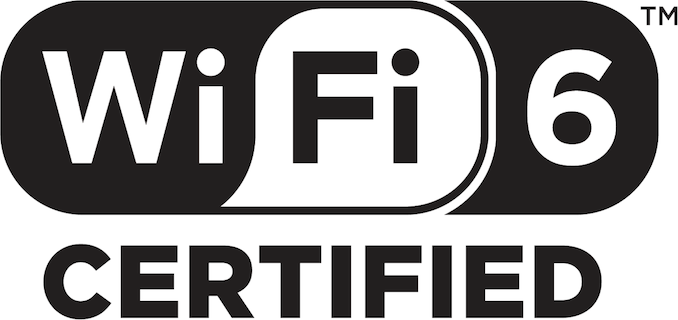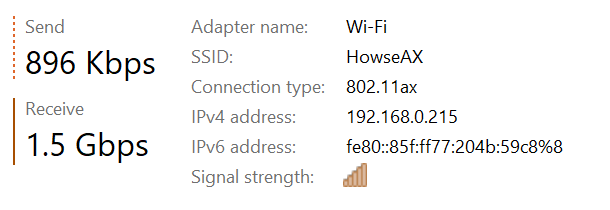AT 101: Wi-Fi 6 And Why You Want It
by Brett Howse on February 12, 2020 8:00 AM ESTTo The Future
If the question is do you need Wi-Fi 6, the answer is most assuredly “maybe”. The performance improvements are substantial, but really rely on a very strong signal to get the most data throughput. Most of the new features of Wi-Fi 6 focus on the influx of devices to the standard, and dealing with many devices connected to the same access point, or devices trying to share spectrum when connected to different access points.
The addition of Orthogonal Frequency Division Multiple Access to the Wi-Fi 6 standard will likely be the most impactful change to this revision. It will allow access points to carve up their channels into smaller slices, allowing more devices to communicate at the same time with less overhead. Each device will lose out on peak throughput, but the reduced latency should help a lot, especially in very dense environments. It should help with excessive overhead on the network layer when multiple devices are sending many small packets at once, which is a very common scenario, especially in an office or stadium situation.
Multi-User MIMO was in the Wi-Fi 5 specification as an optional implementation, and as such it did not really take off. Wi-Fi 6 should make this more prevalent, and also adds support to the MU-MIMO on the uplink, not just the downlink side. This will increase the capacity of access points for higher-speed use cases, but MU-MIMO did not get a lot of traction in Wi-Fi 5 so we will have to see how much adoption it gets in Wi-Fi 6.
The wider 160 MHz channels will offer significantly more throughput in the home environment, as we saw in our performance tests. As with the 1024-level QAM though, to see the biggest benefit you will need a strong signal. The vast majority of home networking is still limited to 1 Gigabit Ethernet, which puts Wi-Fi 6 into somewhat of an awkward spot, since it can transfer faster than most wired home networks, but even so, that is still a significant improvement over Wi-Fi 5 which would cap out around 600 Mbps on the best Wi-Fi adapters. If you work with a lot of large files, and you prefer to use Wi-Fi instead of the more consistent, yet cumbersome Ethernet, there’s still a nice boost to be had.
The future looks strong for Wi-Fi, and the Wi-Fi Alliance has made some excellent revisions to their standard to help improve Wi-Fi for the next generation of devices. As with any standards change, the impacts will not be seen right away. Both the access point, and the client need to be leveraging the new standard for the improvements to be noticeable. We’ve already seen the latest generation of smartphones start to offer Wi-Fi 6, and there’s been some movement in the PC space as well with Intel’s Project Athena. Anyone looking at a new router today should certainly opt for a Wi-Fi 6 model, but there’s likely not a major need for most people to move from Wi-Fi 5 access points right away. If you live in a heavily congested wireless area, the advantages of features like BSS coloring and Spatial Frequency Reuse should help out in those scenarios, but for people looking at purely performance, Wi-Fi 6 somewhat runs into a wall of its own making, since it can now transfer at over Gigabit speeds on a typical 2x2:2 connection. But who are we to question performance?












149 Comments
View All Comments
Impulses - Thursday, February 13, 2020 - link
Is internet that fast really only available to 10% of the US population or was that an off the cuff "stat"...I'm surprised it's still that bad if that's accurate, I used to weep along with everyone else when I'd see comments like this but I've had 1Gbps (up/down) fiber at home for over a year now in a US territory that isn't exactly known for having it's stuff/infrastructure together (Puerto Rico)... For $70/month, no clue how competitive that is but it's affordable enough for me and well worth it (nor any more expensive than a lower speed package from the cable ISP).
Cable company is doing it's own fiber rollout to compete and they already offer 500Mbps over coax (tho 250-300Mbps is really what's sanely priced, the premium for the top tier isn't worth it). I was actually complacent with my 250mbps service with them but I'm glad to see some competition in the market.
Obviously those services aren't available island wide tho, I really dunno what % the rollouts are at... The fiber ISP has taken an interesting approach where they poll neighborhoods to decide where to build next.
oynaz - Friday, February 14, 2020 - link
1Gbps internet is around 50 euro/month in quite a few parts of Europe.Makaveli - Wednesday, February 12, 2020 - link
The GT-AX11000 has a 2.5Gbps port that can be turn into a WAN Port.YB1064 - Wednesday, February 12, 2020 - link
I see this as a potential problem:"The devices would adapt their power levels for transmission to avoid them actively interfering with each others’ transmissions."
evilspoons - Wednesday, February 12, 2020 - link
It's like two people starting to talk to friends with them in a soft voice instead of shouting louder and louder and making both conversations impossible to understand.Xyler94 - Wednesday, February 12, 2020 - link
That's how enterprise gear works, it's to avoid interference, which is worse than modulating power. boosting signal introduces noise, the less boosting you need to do, the better.Whiteknight2020 - Wednesday, February 12, 2020 - link
Because who has greater than 1Gbit ISP connections?Makaveli - Wednesday, February 12, 2020 - link
My ISP provides 1.5Gbps Fiber connection with a plan to offer 5Gbps in the future.Whiteknight2020 - Thursday, February 13, 2020 - link
And no more than a couple of dozen people in the entire UK can get over 1gbps. And even if you could get it, what, as a consumer, would you use it for? Unless you have a houseful of individuals all watching different 4k streams it's got absolutely no use case.CharonPDX - Wednesday, February 12, 2020 - link
Many routers, including the Asus they're using as their testbed, include a >1Gb port that can be used as either LAN *OR* WAN. If you set the 2.5Gb port to WAN, the "nominally WAN" port becomes another 1 Gbit LAN port.Yes, I'd prefer *TWO* >1Gb ports, one for WAN and one for LAN (or configurable,) but hey, one is better than none.
Most, even the ones without a >1Gbit port, also support bonding the WAN and one (or more) LAN ports.
Note that most >1Gbit internet services' modems don't yet have >1Gbit ports! The one available locally to me has a modem with two 1Gbit ports that if you want faster than 1 Gbit, you *HAVE* to use them bonded. (It also has a built-in WiFi router, and if you use the built in router, it allows >1Gbit *TOTAL* bandwidth, just not >1Gbit to any individual device.)